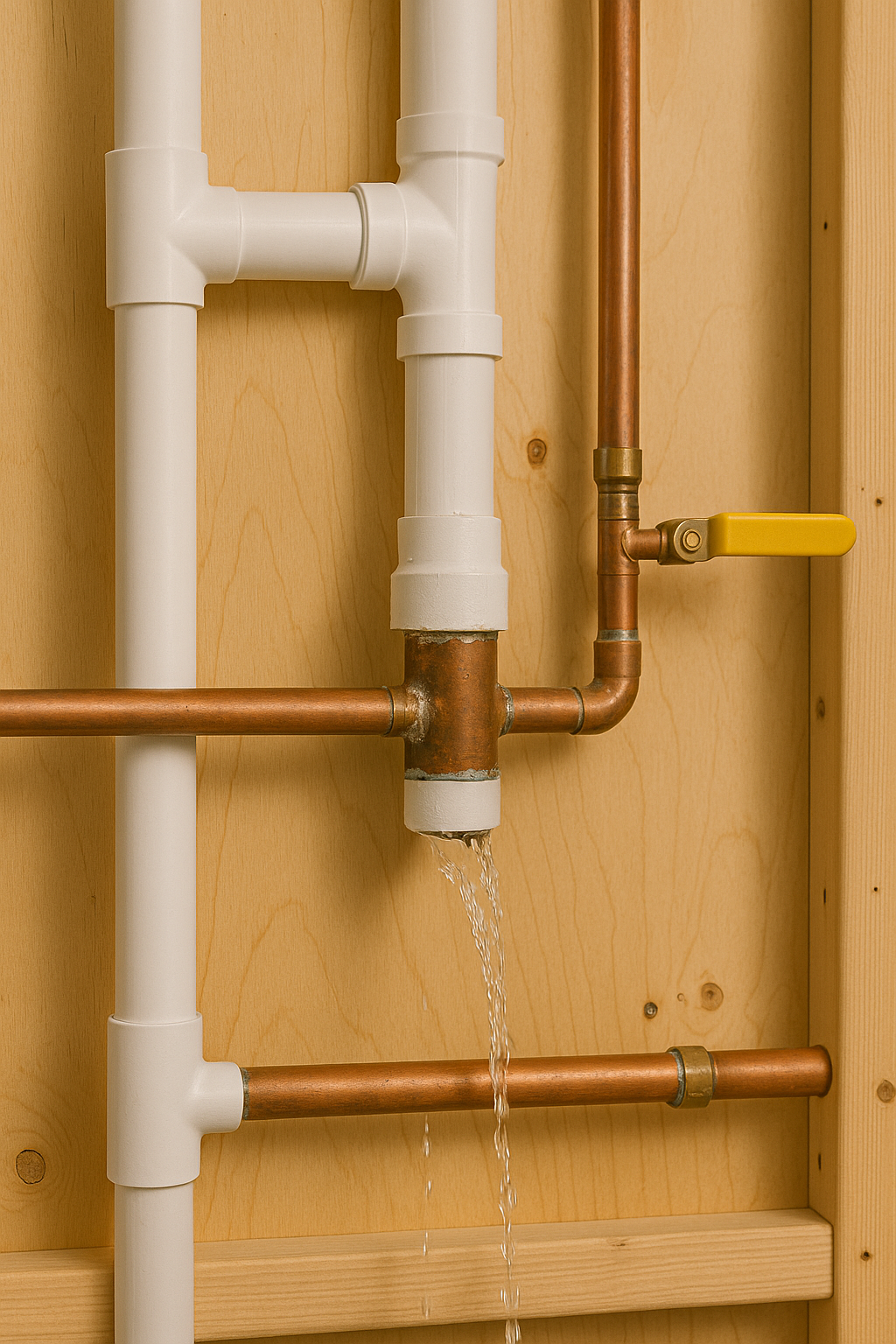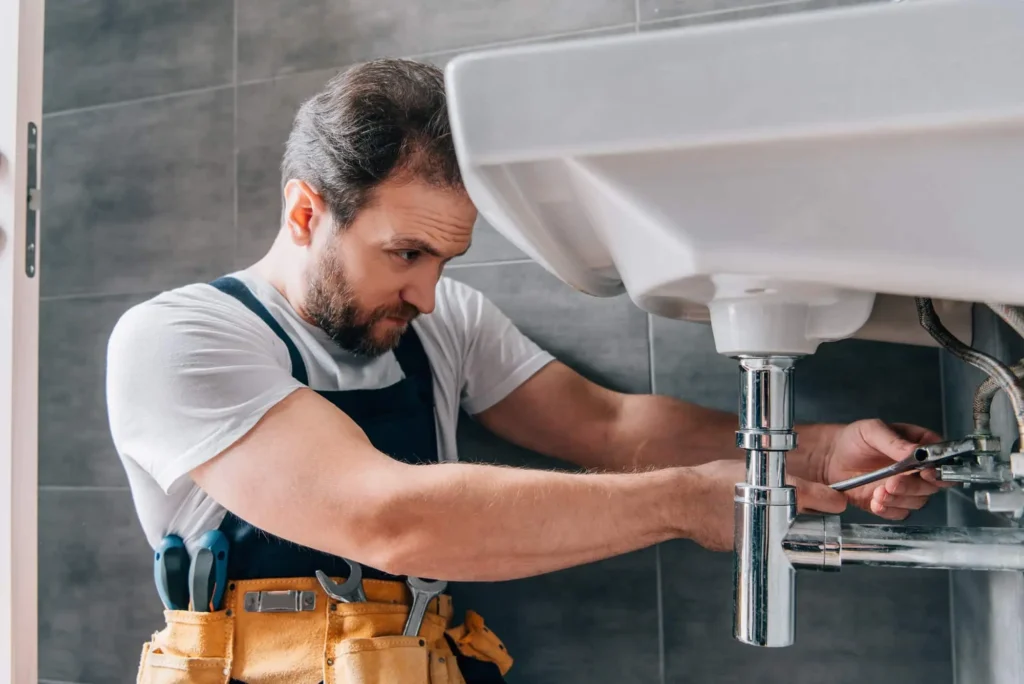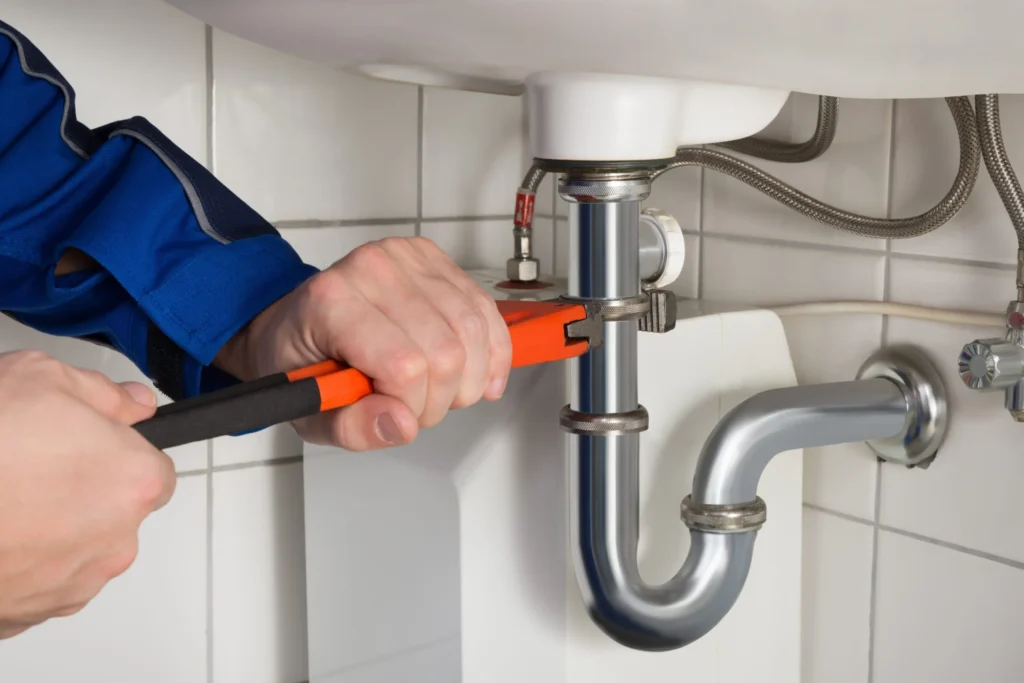

When Lisa noticed a small puddle forming beneath her kitchen sink, she knew something was wrong. Upon closer inspection, she discovered a leaking pipe a slow but steady drip coming from a tiny pinhole in one of the water lines. Concerned about potential water damage and mold, she acted quickly and shut off the water supply to the affected line. After drying the area around the sink drain pipe leaking problem, Lisa confirmed the source: a small pipe leak in a section of copper tubing. Though the damage looked minor, she knew even a tiny leaky pipe could lead to major trouble if left unattended.
Drawing on some DIY knowledge she’d picked up from a home improvement blog, Lisa reached into her toolbox and pulled out a roll of waterproof repair tape. She tightly wrapped the tape around the damaged area, overlapping it multiple times to help seal the leaking pipe as best she could. Wanting to reinforce the fix, she cut a piece of rubber from an old garden hose, placed it over the leak, and secured it with a pipe clamp she had recently picked up from the hardware store. Lisa cautiously turned the water back on. To her relief, the temporary leaking pipe repair held up no more dripping, at least for the moment. Still, she understood that a quick patch wouldn’t last forever. A temporary leaky drain pipe repair is just that temporary. So Lisa did the smart thing and called Fast Plumbing and Drain, a trusted plumbing repair service in her area, to schedule a professional solution.
The plumber arrived promptly and praised Lisa’s quick thinking, noting that her DIY leaky pipe repair likely saved her from more serious water damage. He shut off the water supply again, then carefully cut out the damaged section of the pipe. Using new materials and professional-grade tools, he replaced the faulty piece, completing a long-lasting water pipe leak repair that would give Lisa peace of mind. With the job done and her kitchen back to normal, Lisa was relieved and thankful she had acted quickly. What started as a minor sink pipe leaking issue could have turned into a major disaster but thanks to her proactive approach and a reliable plumber, her home was safe and dry.
You can fix a leaking pipe yourself – temporarily. You can get a short-term fix to buy some time and decide upon next steps using basic tools and materials available at most hardware stores. Here’s how:
Clean and dry the area around the leak. Knead plumbing epoxy putty until pliable, then press it firmly over the leak, shaping it to overlap the damaged area. Allow it to cure as per manufacturer’s instructions before turning the water back on.
A pipe repair clamp consists of a metal band and a rubber gasket. Place the clamp so the gasket covers the leak, then tighten the bolts to compress the gasket against the pipe, creating a watertight seal.
For small leaks, wrap a piece of rubber (like from an old hose) around the pipe and secure it tightly with adjustable pipe clamps on either side of the leak.
Some kits include a resin-coated wrap that hardens around the pipe. After applying epoxy putty, wrap the saturated cast around the pipe, overlapping the putty, and let it set.
Always shut off the water to the affected pipe before starting any repair.
Wipe away any water and debris so repair materials will adhere properly.
Use epoxy putty, a repair clamp, or a patch as described above.
Once the repair has set, slowly turn the water supply back on and inspect for leaks.


Any pipe leak will need a professional plumber. For a long-term solution, the leaking section of pipe usually needs to be cut out and replaced with new pipe and fittings. This may require soldering, gluing, or using push-fit connectors, depending on the pipe material.
Our professional plumbers have the training and experience to quickly identify the root cause of a leak and understand the complexities of different plumbing systems. This ensures the repair addresses the underlying problem, not just the symptoms.
Fixing leaks often requires specialized tools and technology—such as acoustic leak detectors, thermal imaging cameras, and video inspection equipment—that most homeowners do not have. These tools allow plumbers to pinpoint leaks accurately and repair them efficiently, minimizing unnecessary damage to your home.
Our plumbers ensure repairs are durable and meet current building codes and regulations, reducing the risk of recurring leaks, water damage, or costly fines from code violations.
Leaks near electrical wiring, gas lines, or in hard-to-reach areas (like behind walls or ceilings) can be dangerous to repair without professional knowledge. Mistakes could lead to water damage, mold, or even personal injury.
Prompt, professional repairs prevent extensive water damage, mold growth, structural issues, and ruined furnishings, all of which can be much more expensive to fix if the leak is not properly addressed.
While DIY repairs might seem cheaper, mistakes can lead to bigger problems and higher costs down the line. Professional plumbers work efficiently, saving you time and money by getting the job done right the first time.
In summary, while temporary DIY fixes can provide short-term relief, our professional plumber delivers a safe, effective, and lasting solution for leaking pipes—protecting your home and investment.
Our plumbers employ a thorough, step-by-step process to fix a leaking pipe, ensuring a durable and code-compliant repair:
The plumber begins by inspecting the visible pipes and joints to locate the exact source and extent of the leak. For hidden leaks (behind walls, ceilings, or floors), specialized tools or visual cues like wet spots or discoloration are used to pinpoint the problem.
Before starting any repair, the plumber turns off the main water supply to prevent further water damage and drains the affected line by opening nearby faucets.
The area around the leak is dried and cleaned to ensure that repair materials will adhere properly. If the pipe is behind a wall or ceiling, the plumber may carefully remove the necessary section to access the damaged pipe.
The plumber typically cuts out the damaged section of pipe using a pipe cutter or hacksaw. The ends of the remaining pipe are cleaned and prepared for the new section. Copper pipes: The plumber will solder (sweat) a new section into place, applying flux and heating the joint before adding solder for a watertight seal. Plastic pipes (PVC/CPVC): The plumber uses primer and solvent cement to join the new section, holding it in place until the bond sets. Slip couplings or push-fit connectors: These may be used for a variety of pipe materials to quickly and securely connect the new section without extensive work.
Once the repair is complete, the plumber slowly turns the water supply back on and checks for leaks by observing the repaired area under pressure.
If any walls or ceilings were opened, the plumber may patch them or advise the homeowner on restoration. The work area is cleaned up, and the plumber ensures the system is functioning properly.
This process ensures that the leak is not only stopped but also that the repair is strong, safe, and long-lasting, preventing further water damage or future leaks.



We ensure quality service, offer guarantees, and provide ongoing support. Here’s what we do:
We provide a warranty on our workmanship. If there are installation errors or faulty work, it will be corrected.
We install reliable, energy-efficient plumbing components from reputable brands. We use manufacturer-approved parts to ensure longevity and performance.
We ensure the equipment is installed to the manufacture’s specifications, preserving the warranty.
We test the system post-installation to confirm proper operation. We then check for issues and seals before completing the job.
We provide customers a detailed invoice outlining the work performed, parts used, and warranty terms.
We encourage customers to enroll in our preventative maintenance plan for ongoing tune-ups and priority service.
We check in with customers after installation or repair to ensure satisfaction. We also offer 24/7 emergency support in case of urgent issues.
We stay up to date with state plumbing licensing through the Washington State Department of Labor & Industries and the Uniform Plumbing Code, and ongoing training.
By backing up our customers, we provide peace of mind and ensure long-term satisfaction with our work.
We’re a second-generation business with over 40 years of on-the-job experience. Our deep knowledge means we diagnose and solve problems faster, saving you time and money.
No hidden fees or surprise upcharges. The price we quote is the price you pay.
We offer warranties that protect your plumbing system —1 year on parts and 3 years on labor for new installations.
We go the extra mile to ensure no dings on your walls or scratches on your floors during repairs.
All our plumbers undergo criminal background checks and drug tests, so you can feel confident in who’s in your home.
We believe in offering pricing that reflects real value—ensuring you get the plumbing service you need without having to overpay.


To temporarily fix a leaky drain pipe, you can use rubber patches and pipe clamps, epoxy putty, or a pipe repair wrap. Clean and dry the area first, apply the chosen material, and ensure a tight seal. However, for a permanent solution, it’s best to call a professional to fully replace the damaged section of pipe.
A sink pipe leaking under the kitchen or bathroom can lead to water damage and mold. First, turn off the water supply, place a bucket to catch any drips, and apply a temporary seal using waterproof tape, epoxy, or a rubber clamp. Then call a professional plumber for a proper leaky pipe repair.
To seal a leaking pipe temporarily, use repair tape, a pipe clamp with a rubber gasket, or epoxy putty. These DIY methods can stop the leak for a short time, but a proper leaking pipe repair requires replacing the damaged section with the right fittings and tools.
Leaky copper pipe joints often require cutting out the damaged section and soldering in a new piece. This process involves cleaning the ends, applying flux, and using a torch to melt solder for a watertight seal. If you’re not familiar with soldering, we recommend professional water pipe leak repair.
For plastic water pipe joints, such as PVC or CPVC, you’ll need to cut out the leaking section, apply primer and solvent cement, and install a new fitting. If the joint continues leaking after that, it may indicate a poor bond or alignment issue, and expert help is advised.
A sink drain pipe leaking can be caused by corrosion, loose connections, cracked plastic fittings, or failed seals. Over time, wear and tear weaken the pipe and fittings. A plumber can assess whether a replacement or leaky drain pipe repair is needed.
Call a plumber if your pipe leak persists after a DIY fix, the leak is near electrical or gas lines, or if water damage is already visible. DIY repairs may hold temporarily, but a licensed plumber ensures safe, lasting leaking pipe repair.
Yes, but only for a temporary leaky pipe repair. Using repair clamps, epoxy, or wraps can stop minor leaks short term. However, professional plumbers can replace pipes, solder joints, and ensure everything meets code—critical for preventing further leaks or property damage.
Plumbers typically shut off the water, locate the pipe leaking area, and cut out the damaged section. Depending on the pipe material, they’ll use soldering, solvent cement, or push-fit connectors to install new parts. The line is then tested for leaks under pressure.
Let’s bring your vision to life with expert craftsmanship and thoughtful design.
16120 Woodinville Redmond Rd NE STE. 15
Woodinville, WA 98072
(425) 629-9564
hello@fastwaterheater.com
Monday – Friday 7:30am-5pm
24/7 Emergency Service Available
Construction
FASTWWH948BC
Plumbing
FASTWWH79901